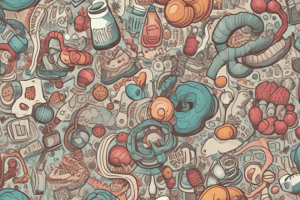Podcast
Questions and Answers
What is the primary function of liver glycogen?
What is the primary function of liver glycogen?
- To synthesize ATP during fasting
- To serve as a fuel reserve for muscle contraction
- To store glucose in plants
- To maintain blood glucose levels (correct)
What is the difference between glycogen and amylopectin?
What is the difference between glycogen and amylopectin?
- Glycogen has more α-1,4 linkages, while amylopectin has more α-1,6 linkages
- Glycogen is a homopolymer of glucose, while amylopectin is a heteropolymer
- Glycogen has more branching points, while amylopectin has fewer branching points (correct)
- Glycogen is found only in animals, while amylopectin is found only in plants
What is the ratio of glycogen in muscle to glycogen in liver?
What is the ratio of glycogen in muscle to glycogen in liver?
- 2:1
- 1:3
- 1:1
- 3:1 (correct)
What is the storage form of glucose in plants?
What is the storage form of glucose in plants?
What type of bonds link glucose units in glycogen?
What type of bonds link glucose units in glycogen?
What is the term often used to refer to glycogen?
What is the term often used to refer to glycogen?
What type of bond is formed at the branch points in glycogen?
What type of bond is formed at the branch points in glycogen?
What is the primary function of cellulose in plants?
What is the primary function of cellulose in plants?
What is the monomer unit of cellulose?
What is the monomer unit of cellulose?
What is the difference between alpha-1,4 and alpha-1,6 glycosidic bonds in glycogen?
What is the difference between alpha-1,4 and alpha-1,6 glycosidic bonds in glycogen?
What is the function of inulin in plants?
What is the function of inulin in plants?
What is the difference between cellulose and chitin?
What is the difference between cellulose and chitin?
What is the molecular structure of glycogen?
What is the molecular structure of glycogen?
What is the function of glycogen in animals?
What is the function of glycogen in animals?
What type of bonds are present in cellulose?
What type of bonds are present in cellulose?
What is the function of chitin in insects?
What is the function of chitin in insects?
Why is cellulose indigestible to humans?
Why is cellulose indigestible to humans?
What is the monomer unit of chitin?
What is the monomer unit of chitin?
What is the significance of microorganisms in the gut of ruminant animals?
What is the significance of microorganisms in the gut of ruminant animals?
What is the location of chitin in insects?
What is the location of chitin in insects?
What type of glycosidic bonds are present in chitin?
What type of glycosidic bonds are present in chitin?
Where can the breakdown of cellulose occur in humans?
Where can the breakdown of cellulose occur in humans?
What is the characteristic of a reducing sugar?
What is the characteristic of a reducing sugar?
Which of the following disaccharides has no reducing properties?
Which of the following disaccharides has no reducing properties?
What is the characteristic of an oligosaccharide?
What is the characteristic of an oligosaccharide?
Which of the following is an example of a polysaccharide?
Which of the following is an example of a polysaccharide?
What is the type of glycosidic bond found in maltose?
What is the type of glycosidic bond found in maltose?
What is the function of reducing sugars?
What is the function of reducing sugars?
What is the characteristic of a non-reducing sugar?
What is the characteristic of a non-reducing sugar?
What is the significance of oligosaccharides in ABO blood type specificity?
What is the significance of oligosaccharides in ABO blood type specificity?
What is the characteristic feature of polysaccharides that distinguishes them from monosaccharides?
What is the characteristic feature of polysaccharides that distinguishes them from monosaccharides?
What is the term for polysaccharides composed of a single monosaccharide building block?
What is the term for polysaccharides composed of a single monosaccharide building block?
Which of the following polysaccharides is a structural element in the exoskeletons of insects?
Which of the following polysaccharides is a structural element in the exoskeletons of insects?
What is the approximate percentage of amylopectin in starch?
What is the approximate percentage of amylopectin in starch?
What type of bonds are present between glucose units in amylopectin?
What type of bonds are present between glucose units in amylopectin?
What is the function of starch in plants?
What is the function of starch in plants?
Which of the following is a characteristic of amylose?
Which of the following is a characteristic of amylose?
What is the difference between starch and glycogen in terms of branching?
What is the difference between starch and glycogen in terms of branching?
Flashcards are hidden until you start studying
Study Notes
Disaccharides
- Disaccharides are formed by joining two monosaccharides with a glycosidic linkage.
- Examples of disaccharides include:
- Maltose (malt sugar) = glucose + glucose
- Sucrose (table sugar) = glucose + fructose
- Lactose (milk sugar) = glucose + galactose
- Sucrose has no reducing properties due to the lack of a free anomeric carbon.
Reducing Sugars
- Reducing sugars are capable of reducing Benedict's solution, which is an alkaline cupric solution.
- A sugar is a reducing sugar if it possesses a free anomeric carbon.
- Examples of reducing sugars include:
- All monosaccharides
- Disaccharides: maltose, lactose
- Examples of non-reducing sugars include:
- Sucrose
Oligosaccharides
- Oligosaccharides are saccharide polymers containing a small number (typically three to ten) of simple sugars (monosaccharides).
- Examples of oligosaccharides include:
- Maltotriose (3 glucose units, α-1,4 linkage)
- Dextrin (6-8 glucose units)
- Oligosaccharides also occur in glycoproteins and glycolipids, which are proteins and lipids to which oligosaccharides are covalently attached.
Polysaccharides
- Polysaccharides are high molecular weight polymers composed of more than 10 monosaccharide units linked together.
- Polysaccharides are insoluble in water.
- Polysaccharides can be polymers of hexose or pentose sugars.
- Homopolysaccharides are composed of a single monosaccharide building block, while heteropolysaccharides are composed of more than one type of monosaccharide.
- Polysaccharides can be linear or branched polymers.
- Examples of homopolysaccharides include:
- Starch (storage form of glucose in plants)
- Glycogen (storage form of glucose in animals)
- Cellulose (structural element of plants)
- Chitin (structural element in the exoskeletons of insects)
- Inulin (found in roots of some plants)
Starch
- Starch is a storage polysaccharide in plants composed of alpha glucose.
- Its structure is identical to glycogen, except for a much lower degree of branching (every 20-30 residues).
- Starch consists of two types of molecules:
- Unbranched chains called amylose (15-20%)
- Branched chains called amylopectin (80-85%)
- Amylose is a continuous, unbranched chain of glucose units linked by α-1,4 glycosidic bonds.
- Amylopectin is a branched-chain polysaccharide with α-1,4 glycosidic bonds between the glucose units and α-1,6 bonds to branches.
Glycogen
- Glycogen is the storage form of glucose in animals.
- It is stored in the liver and muscle.
- Glycogen is a homopolymer of glucose in α-1,4 linkage.
- It is highly branched, with α-1,6 branch linkages occurring every 8-11 residues.
- Glycogen has the same overall structure as amylopectin but with more branching in the molecule.
- Glycogen is a very compact structure that results from the coiling of the polymer chains.
Structural Polysaccharides
- Cellulose is a structural polysaccharide in plants composed of beta glucose units.
- It is a major constituent of plant cell walls and provides structure and support.
- Cellulose is indigestible to humans because it cannot be broken down by human enzymes.
- Chitin is a structural polysaccharide in the exoskeletons of insects, providing protection and support.
- It is a polymer of N-acetylglucosamine units linked by β-1,4 glycosidic bonds.
- Inulin is a structural polysaccharide found in the roots of some plants.
Studying That Suits You
Use AI to generate personalized quizzes and flashcards to suit your learning preferences.




